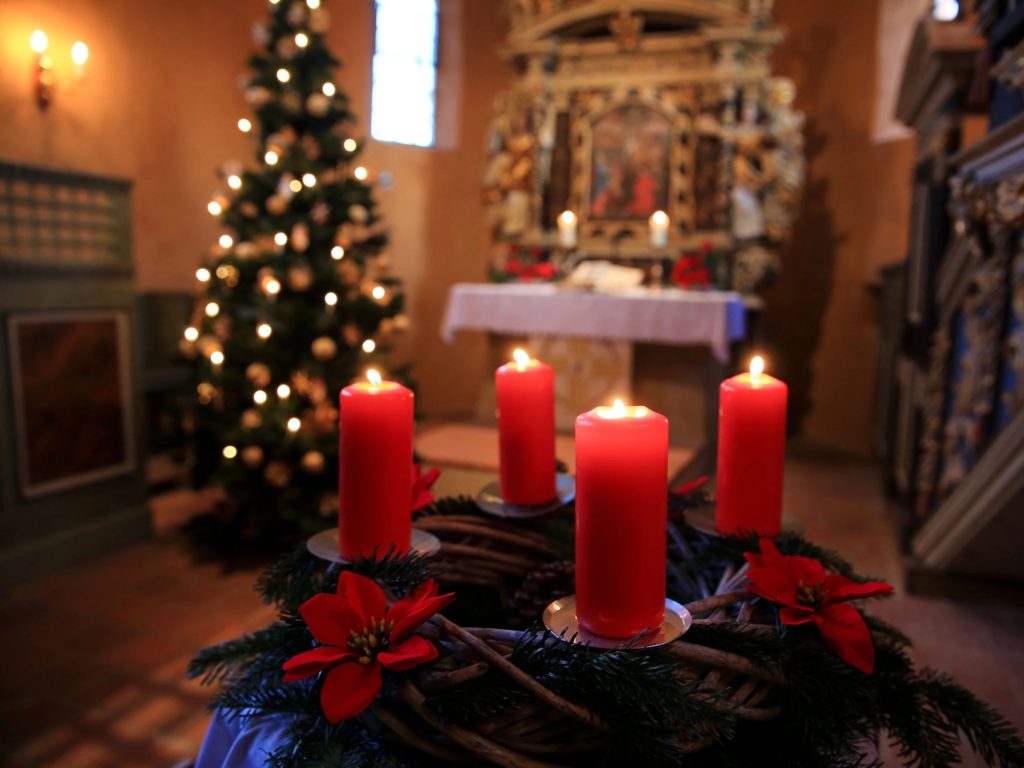The pre-Christmas period, which gets its name from the Latin word for arrival, serves as a countdown to Christmas when Christians honour the birth of Jesus Christ.

(In the weeks before Christmas, churches around the world celebrate Advent—a season of reflection and preparation for the birth of Jesus Christ. Candlelight Advent wreaths like this one inside the Sankt-Petri church in Magdeburg, Germany—signify light in the dark days of winter.)
During the darkest days of winter, Christians prepare for one of their religion’s most important holidays during the season of Advent. Lasting roughly four weeks, it’s a season of candlelight, reflection, and expectation—a chance to get ready for Christmas, the celebration of the birth of Jesus Christ.
The season’s dates vary from year to year. In 2021, Advent begins on Sunday, November 28, and ends on Friday, December 24.
The origins of Advent
Advent gets its name from adventus, the Latin word for “arrival.” As the Christian church solidified in the fifth century A.D., so did traditions around December 25. Historians have tracked the first formal Advent celebrations to northern Italy, where churchgoers observed a weeks-long preparation for Christmas that involved fasting, prayer, and reflection on Christian values.
Eventually, that preparation became known as Advent. By the sixth century, Christians in France celebrated a five-week “St. Martin’s Lent” that included fasts and abstaining from sexual intercourse leading up to Christmas.
Advent is now considered the first season of the liturgical year, the church’s annual cycle of feast days and Scripture readings. Much like their ancestors, modern Christians see it as a season of preparation in honour of Christ. Advent is celebrated on four consecutive Sundays, beginning on the Sunday closest to November 30 and ending on December 24, Christmas Eve.
Each Sunday has a traditional meaning and prayers and readings assigned to it; they represent, in order, the Christian virtues of love, joy, hope, and peace. For believers, Advent represents a multi-faceted period during which to prepare for the birth of Christ, celebrate faith in and conversion to Christianity, and anticipate the eventual resurrection of the son of God.
The Advent wreath
Considered a season of light in the dark apex of winter, Advent is symbolised in the church by a candlelit evergreen wreath. In 1838 Johann Wichern, a German Lutheran pastor, began using this wreath to help his congregation count down the days until Christmas. (The surprising history of Christmas trees—a tradition that likely also took root in Germany.)
The modern Advent wreath has four candles. The first two and the fourth are purple, Advent’s traditional colour. The third candle is pink, representing the halfway point of Advent and the joy of the coming holiday.
Christians traditionally pray, sing, and light an additional candle on each Advent Sunday until all of the candles are lit on the fourth Sunday. A fifth, white candle known as the Christ candle sometimes sits unlit in the centre of the wreath; it is only lit on Christmas Eve.
Advent calendars
Another German Advent tradition is the Advent calendar. During the 19th century, adults began helping children count down the days until Christmas. Beginning on December 1, some German Lutherans made chalk marks on doors in anticipation of the entry of the Christ child, and other parents created homemade ways to count down involving snacks and Bible verses.
In 1908 German printer Gerhard Lang produced the first printed Advent calendar. In his childhood, his mother had handcrafted a calendar with cardboard doors and candy inside. Lang adapted the idea for the printing press, and his wares became extremely popular in Germany. But World War II-related shortages and Nazi Germany’s secular rebranding of Christmas almost killed off the printed Advent calendar.
After the war, another German printer, Richard Sellmer, obtained permission from American occupying forces to print a 1946 Advent calendar. He used his contacts with Americans to introduce the Advent calendar in the United States, and with the help of President Dwight D. Eisenhower, who was photographed opening one with his grandchildren in 1953, they became increasingly popular in the U.S.
Even though Advent technically begins in late November, modern Advent calendars typically start on December 1 and have small doors or boxes containing pictures, trinkets, or food like chocolate to be opened and consumed in the leadup to Christmas. Retailers have invested big in the Advent calendar game, and consumers can choose Advent calendars centred around beauty, popular characters, or even consumption.
Like other Christmas traditions, Advent calendars became increasingly secularised in the 20th and 21st centuries. But its traditions remain a fun way for both kids and adults to ramp up Christmas delight during a dark, wintry month.
*WRITTEN BY ERIN BLAKEMORE, PUBLISHED IN NATIONAL GEOGRAPHIC ON 30 NOV 2021
(PHOTOGRAPH BY PETER GERCKE. PICTURE ALLIANCE/GETTY)